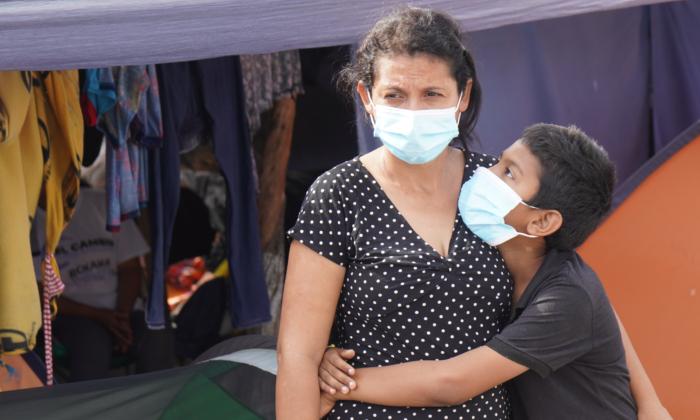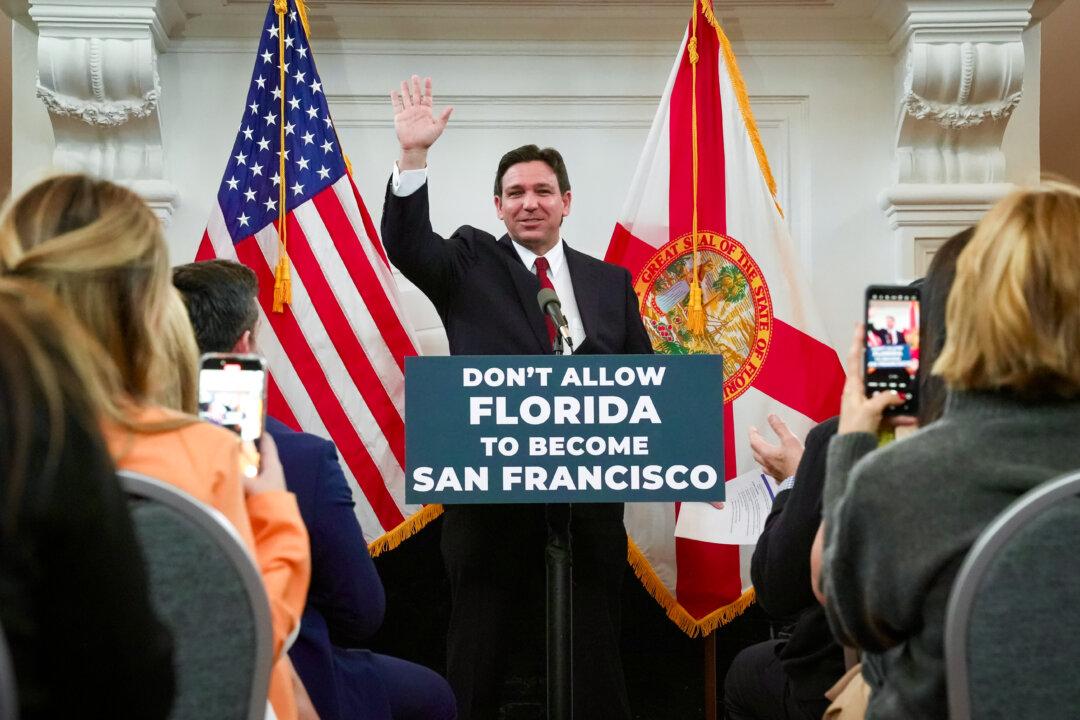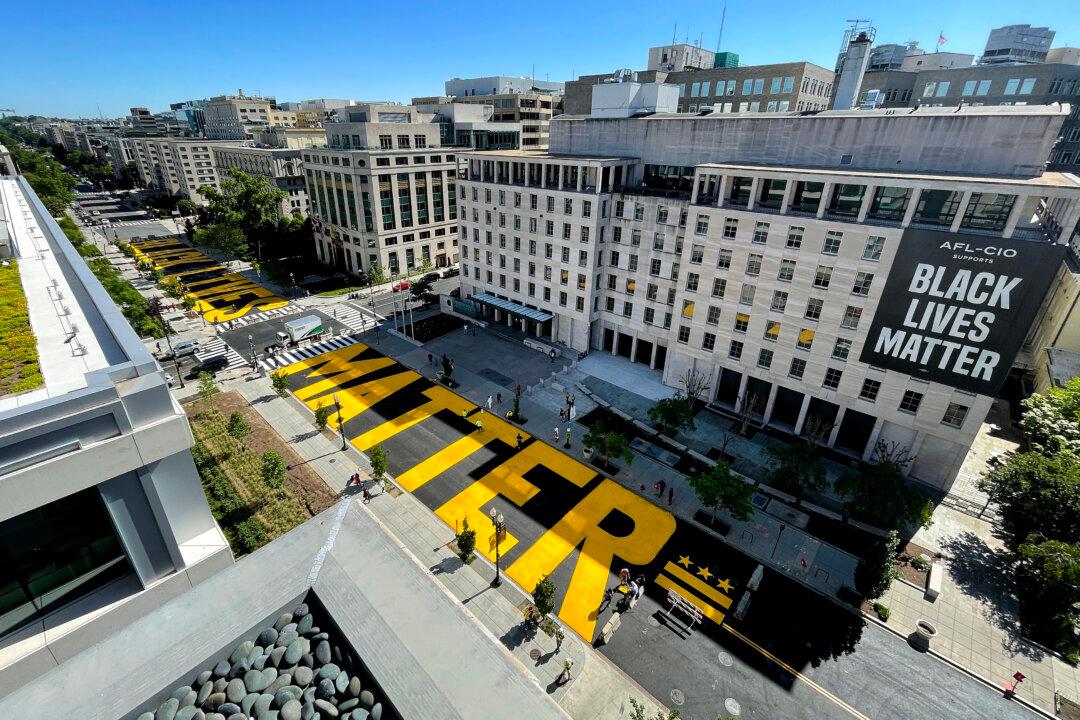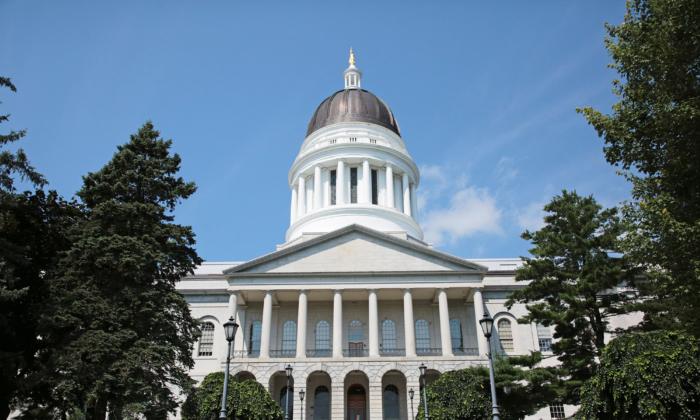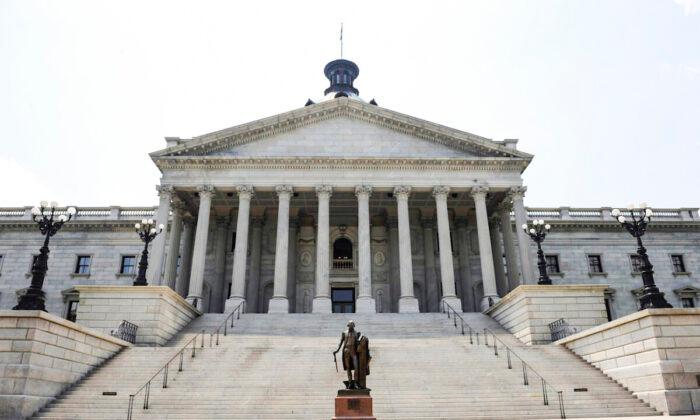The 3-month-old baby in the airplane had a scabby forehead and dirty fingernails, yet she was a dark-eyed darling in her father’s arms. She was named after her dead mother, Maria Isabella, and she had spent her life to that point traveling north from El Salvador.
All she knew was her family’s passage to the U.S. border. She waggled her head back and forth when she cried.
Her father’s name was Santo—“Saint”—and he had suffered enough to be one. He had taken his four children more than a thousand miles north with only a purse-sized travel bag.
In El Salvador, he was a thick-handed, hard-nailed field worker who turned maize into tortillas.
He planned to work in a laundromat. It would be better for his children there, he said.
He didn’t know how to buckle or unbuckle an airplane seatbelt. He didn’t know how to navigate an airport.
“La vida es dura,” he said. “Life is hard.”
He was like everyone else who crosses illegally into “Los Estados Unidos.” He didn’t speak a word of English and had no backup plan.
Origins
“When Mexico sends its people, they’re not sending their best,” President Donald Trump once said.But the illegal aliens don’t come from Mexico alone. In interviews at and across the border in McAllen, Texas, The Epoch Times spoke to people from El Salvador, Honduras, or Guatemala as well.
The Tents
Many people waited in the Mexican border town of Reynosa.Reynosa has a plaza, a football-field-sized space bound by streets. It once had grass and trees between its stone paths. Now, the grass is entirely gone, worn to packed gray dirt by thousands of people who live there in donated tents, waiting to cross the border.
In one corner, about 20 port-a-potties sit a couple of yards from the tents where people slept through 80-degree nights. Nearby, there was a small water tank.
Deeper in the square, a small shop set up on a table sold store-bought pound cake by the slice. Adela, a barber in training, offered haircuts at a third of the local prices.
“They need it,” she said.
Between the tents, tarps provide a slight respite from the sun.
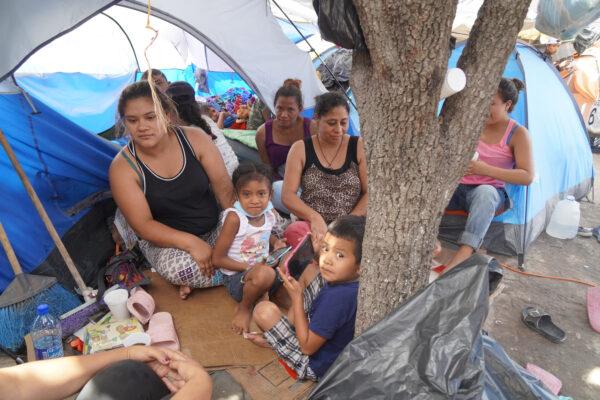
On average, the people stood a foot shorter than most Americans. Rail-thin girls hung on to their parents.
The adults looked worried, with stares of sad exhaustion. There was nothing to do.
Gerardo Lopez Ortiz, a Honduran, said he fled to the United States to escape gang violence.
“Gangs threatened me and fired into where I was living so I would get out, because I wouldn’t help them in what they wanted to do,” he said. “The churches have supported us with food. We don’t suffer for lack of food, but because we can’t sleep well. My bones ache. I need eye surgery.”
Ortiz’s right eye had a visible bulge. He said he couldn’t see at all at night.
The children were different. They shouted, smiled, and played, expertly throwing spinning tops called “trompos” that whipped off a string. It was hard to get the hang of it.
“We play trompos together all day,” one child said.
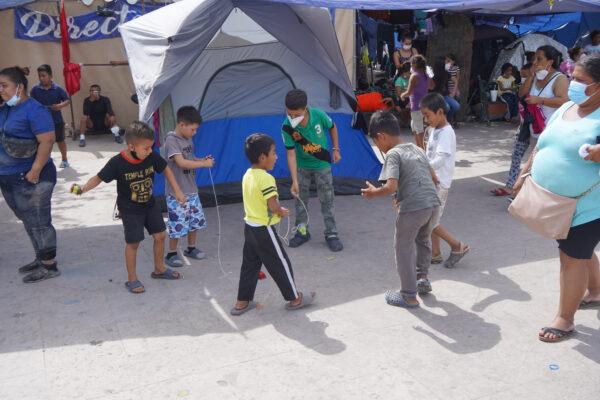
But when they were still, an expression similar to that of the adults revealed itself. A few wanted to be lawyers or policemen. On that day, they were worried about drowning while crossing the Rio Grande.
The people in Reynosa’s plaza waited, sweated, and slept, often two families to a tent.
Most had been there sharing tents with strangers for two months. They wanted lawyers to help them cross legally.
“I left my country because my husband has another woman. He beat me. He doesn’t want to see me again,” said Natalia, a Guatemalan. “That’s why I left with my children, so they can eat. My little girl is always getting sick with fever because of the heat. We’re bored being here, but what can we do?”
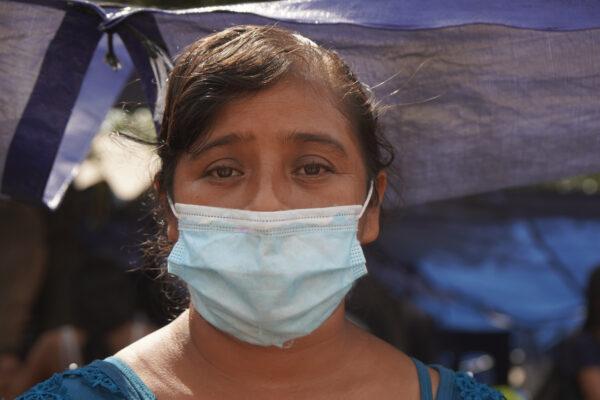
The Border
The unsolved mystery of border crossing is how people come up with the money to do it, said Pastor Roberto Sanchez, the leader of a church in San Juan. He ministers to illegal immigrants after they’ve arrived.To cross the border with a coyote, illegal immigrants must pay between $12,000 to $15,000, Sanchez said.
“I had to borrow money for my trip,” Natalia said. “I’ve been praying to God to help us get to where we are going, so I can pay off the debt because it keeps growing. Every day that interest grows.”
Crossing
When they cross, most people don’t climb the wall. They take a cartel-owned raft over the Rio Grande and then walk through fields of stubby Texas brush, Sanchez said.Usually, cartel coyotes lead groups of 15 or 20 people through the first part of the crossing. Once they get across, they look for the Border Patrol.
“The cartels pretty much deliver the groups of people to wherever there are clusters of border patrol agents. They almost have an unspoken understanding of where they’re supposed to go,” Sanchez said.
The groups of immigrants wait for the white vans and buses of the patrol to pick them up, Sanchez said. When Border Patrol finds them, they don’t get sent back.
After crossing the border illegally, they’re often given documents so that they can officially apply for asylum. On busy days, dozens will sit on train tracks filling out forms.
Conspiracy
In McAllen, Texas, it seems the federal government has ignored “illegal” and emphasized “alien.”Border crossers can come in, but Border Patrol isolates them from local people and from media.
The moment illegal immigrants cross the border, Border Patrol rushes to tell them not to speak with Americans or answer their questions, Sanchez said. It even tries to head off ministry groups.
“Over in Mexico, you can talk to them for free,” Sanchez said. “But as soon as you cross the river, you can’t talk with the same groups of people.”
In McAllen, the 2 million illegal immigrants who have crossed in the last 8 months are a poorly kept secret.
In the town of Donna, Texas, there’s an illegal immigrant processing facility next to the Donna Housing Authority. It’s a huge fenced-off area filled with white tents.
Sanchez drove me to Anzalduas Park, where he knows Border Patrol keeps illegal immigrants.
A sign at the entrance states “Anzalduas Park is Closed/ Authorized Personnel Only/ For Information Regarding Family Members Please Contact Catholic Charities.”
Catholic Charities of the Rio Grande Valley works with the federal government to house and care for illegal aliens.
Before I could get close enough to see where Border Patrol kept people, two agents stopped me. They refused to explain why.
“Can’t say nothing,” they said. “Can’t say nothing. You can take pictures over there, boss,” they said, indicating an empty field to their right.
This web of secrecy extends to the hotels where Border Patrol keeps illegal immigrants with COVID-19.
One ministry Sanchez knew wanted to drop off food for illegal immigrants in a hotel. When they arrived at the front, the owners said they would accept the food, but that the ministry couldn’t talk with people.
The ministry promised to stay 12 feet away and wear masks the entire time, Sanchez said.
But the hotel even denied this request, said Sanchez. Its owners claimed COVID-19 would remain on the clothes of people who went near the illegal immigrants.
Sanchez and McAllen residents interested in the illegal immigration issue say this secrecy started with the Biden administration.
“Just like seeing stuff on Facebook, it seems like they don’t want you to know what’s going on right now,” said McAllen resident Shannon Farrell. “They don’t want independent reporters to know what’s going on. I don’t know why.”
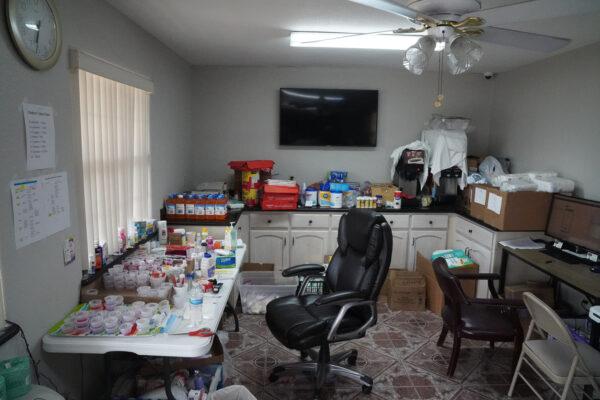
The COVID Hotel
The Fiesta Inn is one of the McAllen hotels that houses and quarantines illegal immigrants with COVID-19.The hotel’s assistant manager, Sam Patel, says Catholic Charities of the Rio Grande Valley asked him to host illegal immigrants with COVID-19. He describes his work as a “humanitarian effort.”
Patel’s work is a marvel of efficiency. To care for rooms full of people with COVID-19, he doubled his staff, established strict food distribution procedures, and organized a system of medicine distribution that minimizes COVID-19 exposure. He transformed his front lobby into a medical supply room that smells strongly of disinfectant.
“I had it this way from the start. I can’t get sick and run this place. What do I have to do to make that happen?” he said.
But the pall of secrecy remains.
“Is this going to be a positive or negative story?” he told an Epoch Times reporter, adding the Catholic Charities ask him to clarify the point.
He didn’t allow The Epoch Times to interview or photograph quarantined illegal aliens for “security reasons.”
One illegal alien quarantined at the hotel had just crossed the border. His jeans were still dusty from the road. He wore a zipped-up jacket, but no shirt underneath.
“It’s been a month since we left Honduras. I came by automobile,” he said.
Most illegal immigrants stay indoors. A few stand outside, mothers with small children or a man with his three-year-old daughter.
The occasional cough comes from rooms, mixed with the sound of Spanish conversation.
Inside, Patel’s rooms are kept clean and well-maintained, if a little shabby.
There was a dime-sized hole on the top of one bedsheet and brown spots on the wall mirror. Service is excellent, however.
Patel said Catholic Charities pays him for each illegal immigrant he houses but refused to say how much.
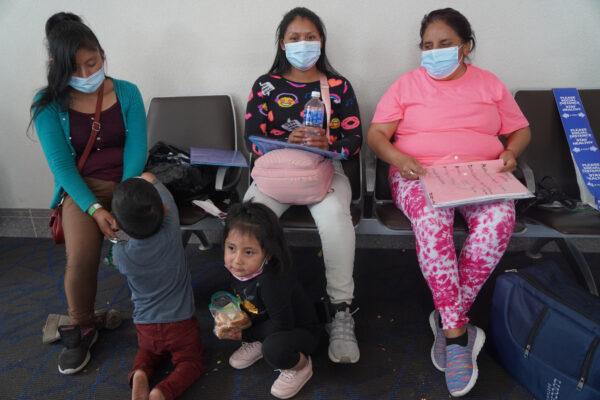
The Airport
After the illegal immigrants spend a few days in a Border Patrol detention center or a few weeks in a COVID-19 hotel, the Border Patrol releases them.They leave McAllen like reverse paratroopers. From the firm ground, the Border Patrol bureaucracy hurls them into an airport, hoping they’ll land at their destination.
Their only guide is a transparent folder with a printed piece of paper in it.
“PLEASE HELP ME,” it reads. “I DO NOT SPEAK ENGLISH.”
They arrive at the tiny single-terminal McAllen Airport. They can’t find their gate without help.
At least in McAllen, almost everyone speaks Spanish. Their next two or three flights will be harder to find.
At the gate to their very first flight, a few dozen illegal immigrant families sit with their children. Two women wear ankle monitors from the Border Patrol. Another shows me a phone from Border Patrol that she says tracks her location.
They aren’t dangerous criminals, and they aren’t sure why the Patrol chose them for ankle monitors, they say. They call them “billetes.”
“The billete has the telephone number so they can watch us all the time because we came illegally to the United States,” Selena says. “We have to carry these billetes until we see what happens with our case. We don’t know how long it will take but we have to carry them. We have to carry them all day long. They are heavy.”
The monitors rub their ankles red.
Between the gate’s seats, a barefoot little boy plays with a girl on the airport floor. He’s not misbehaving; he just doesn’t own shoes.
Boarding
These illegal immigrants have tickets to cities everywhere in the United States.They say they have family, relatives, or a future employer in the cities they’ve chosen.
The men and women sit, exhausted yet alert. A surprising number of them have cell phones.
When the few Americans at the gate stand for the first boarding group, every illegal immigrant rushes into the line.
As far as they know, the intercom announcement for the plane might be saying the last one in line will get sent back to Mexico.
Entering the plane is easier because almost none of them have luggage. A friendly Spanish-speaking stewardess shows them their seats.
I watch Santo struggle with his seat buckle. He’s sitting there like countless thousands like him on countless other flights from McAllen to somewhere completely foreign to them.
The federal government’s plan for moving illegal immigrants from McAllen to McAnywhere through multiple connecting flights relies entirely on the disinterested kindness of the average airport user.
Soon after midnight in the Atlanta airport, a family of illegal immigrants encountered an escalator for the first time. A middle-aged woman named Melanie hesitated before the moving stairs behind her three children, wondering where to put her feet.
When she finally found her terminal, every restaurant in the airport was closed, and the only food the children had was a bag of airplane pretzels. Her flight to New York was scheduled at 8:00 a.m. The little family had only one small suitcase of luggage.
On the chairs outside Atlanta’s Gate T11, they fell asleep hungry, listening to intercom announcements in a language they didn’t understand.
